Spatiotemporal Variation of Vegetation Productivity and Its Feedback to Climate Change in Northeast China over the Last 30 Years
Abstract
1. Introduction
2. Materials and Methods
2.1. Study Area
2.2. Data
2.2.1. GPP Datasets
2.2.2. Auxiliary Datasets
2.3. Statistical Analysis
2.3.1. Mann-Kendall Trend Test
2.3.2. Pearson Correlation
2.3.3. Standardized Multivariate Linear Regression Model
3. Results
3.1. Spatiotemporal Distribution and Variation of GPP
3.2. Relationship between GPPGS and Meteorological Factors
3.3. Relationship between GPP and LAI
4. Discussion
4.1. Differences of Crops and Forests in GPPGS Trend
4.2. Different Trends of GPP and LAI
4.3. Uncertainties and Future Works
5. Conclusions
Author Contributions
Funding
Data Availability Statement
Acknowledgments
Conflicts of Interest
References
- Chapin, M.C.; Matson, P.A.; Mooney, H.A. Principles of Terrestrial Ecosystem Ecology, 2nd ed.; Springer: New York, NY, USA, 2002; p. 102. [Google Scholar]
- Beer, C.; Reichstein, M.; Tomelleri, E.; Ciais, P.; Jung, M.; Carvalhais, N.; Rödenbeck, C.; Arain, M.A.; Baldocchi, D.; Bonan, G.B.; et al. Terrestrial gross carbon dioxide uptake: Global distribution and covariation with climate. Science 2010, 329, 834–838. [Google Scholar] [CrossRef] [PubMed]
- Anav, A.; Friedlingstein, P.; Beer, C.; Ciais, P.; Harper, A.; Jones, C.; Murray-Tortarolo, G.; Papale, D.; Parazoo, N.C.; Peylin, P.; et al. Spatiotemporal patterns of terrestrial gross primary production: A review. Rev. Geophys. 2015, 53, 785–818. [Google Scholar] [CrossRef]
- Jensen, M.N. Consensus on ecological impacts remains elusive. Science 2003, 299, 38. [Google Scholar] [CrossRef]
- Cox, P.; Jones, C. Illuminating the modern dance of climate and CO2. Science 2008, 321, 1642–1644. [Google Scholar] [CrossRef]
- Battin, T.J.; Kaplan, L.A.; Findlay, S.; Hopkinson, C.S.; Marti, E.; Packman, A.I.; Newbold, J.D.; Sabater, F. The boundless carbon cycle. Nat. Geosci. 2009, 2, 598–600. [Google Scholar] [CrossRef]
- IPCC. Land Use, Land-Use Change, and Forestry. In Cambridge University Press; Cambridge University Press: Cambridge, UK, 2000; pp. 1–51. [Google Scholar]
- Zhu, Z.; Piao, S.L.; Myneni, R.B.; Huang, M.; Zeng, N. Greening of the earth and its drivers. Nat. Clim. Chang. 2016, 6, 791. [Google Scholar] [CrossRef]
- Chen, C.; Park, T.; Wang, X.; Piao, S.; Xu, B.; Chaturvedi, R.K.; Fuchs, R.; Brovkin, V.; Ciais, P.; Fensholt, R.; et al. China and India lead in greening of the world through land-use management. Nat. Sustain. 2019, 2, 122–129. [Google Scholar] [CrossRef] [PubMed]
- Monteith, J.L. Solar radiation and productivity in tropical ecosystems. J. Appl. Ecol. 1972, 9, 747–766. [Google Scholar] [CrossRef]
- Monteith, J.L. Climate and the efficiency of crop production in Britain. Phil. Trans. R. Soc. B 1977, 281, 277–294. [Google Scholar]
- Martínez, B.; Sanchez-Ruiz, S.; Gilabert, M.A.; Moreno, A.; Campos-Taberner, M.; García-Haro, F.J.; Trigo, I.F.; Aurela, M.; Brümmer, C.; Carrara, A.; et al. Retrieval of daily gross primary production over Europe and Africa from an ensemble of SEVIRI/MSG products. Int. J. Appl. Earth Obs. 2018, 65, 124–136. [Google Scholar] [CrossRef]
- Running, S.W.; Nemani, R.R.; Heinsch, F.A.; Zhao, M.; Reeves, M.; Hashimoto, H. A continuous satellite-derived measure of global terrestrial primary production. Bioscience 2004, 54, 547–560. [Google Scholar] [CrossRef]
- Chen, Y.; Gu, H.; Wang, M.; Gu, Q.; Ding, Z.; Ma, M.; Liu, R.; Tang, X. Contrasting Performance of the Remotely-Derived GPP Products over Different Climate Zones across China. Remote Sens. 2019, 11, 1855. [Google Scholar] [CrossRef]
- Ferreira, R.R.; Mutti, P.; Mendes, K.R.; Campos, S.; Marques, T.V.; POliveira, C.; Gonçalves, W.; Mota, J.; Difante, G.; Urbano, S.A.; et al. An assessment of the MOD17A2 gross primary production product in the Caatinga biome, Brazil. Int. J. Remote Sens. 2021, 42, 1275–1291. [Google Scholar] [CrossRef]
- Yuan, W.; Liu, S.; Zhou, G.; Zhou, G.; Tieszen, L.L.; Baldocchi, D.; Bernhofer, C.; Gholz, H.; Goldstein, A.H.; Goulden, M.L.; et al. Deriving a light use efficiency model from eddy covariance flux data for predicting daily gross primary production across biomes. Agric. For. Meteorol. 2007, 143, 189–207. [Google Scholar] [CrossRef]
- Yuan, W.; Liu, S.; Yu, G.; Bonnefond, J.M.; Chen, J.; Davis, K.; Desai, A.R.; Goldstein, A.H.; Gianelle, D.; Rossi, F.; et al. Global estimates of evapotranspiration and gross primary production based on MODIS and global meteorology data. Remote Sens. Environ. 2010, 114, 1416–1431. [Google Scholar] [CrossRef]
- Chen, Z. Spatiotemporal variation of productivity and carbon use efficiency of Northeast forests in China from 2000 to 2015. Chin. J. Appl. Ecol. 2019, 30, 1625–1632. [Google Scholar]
- Zhao, J.F.; Yan, X.D.; Jia, G.S. Simulation of carbon stocks of forest ecosystems in Northeast China from 1981 to 2002. Chin. J. Appl. Ecol. 2009, 20, 241–249. [Google Scholar]
- Zhao, X.L. Influence of climate change on agriculture in Northeast China in recent 50 years. J. Northeast Agric. Univ. 2010, 41, 144–149. [Google Scholar]
- Liu, Z.J.; Yang, X.G.; Wang, W.F.; Li, K.N.; Zhang, X.Y. Characteristics of agricultural climate resources in three provinces of Northeast China under global climate change. Chin. J. Appl. Ecol. 2009, 20, 2199–2206. [Google Scholar]
- Ye, D.Z. Simulation Research on Global Change in China; China Meteorology Press: Beijing, China, 1992. [Google Scholar]
- Guo, L.H.; Wu, S.H.; Zhao, D.S.; Yin, Y.H.; Leng, G.Y.; Zhang, Q.Y. NDVI-based vegetation change in Inner Mongolia from 1982 to 2006 and its relationship to climate at the biome scale. Adv. Meteorol. 2014, 1–12. [Google Scholar] [CrossRef]
- Hou, W.; Gao, J.; Wu, S.; Dai, E. Interannual variations in growing-season NDVI and its correlation with climate variables in the southwestern karst region of China. Remote Sens. 2015, 7, 11105–11124. [Google Scholar] [CrossRef]
- Wu, C.; Venevsky, S.; Sitch, S.; Yang, Y.; Wang, M.; Wang, L.; Gao, Y. Present-day and future contribution of climate and fires to vegetation composition in the boreal forest of China. Ecosphere 2017, 8, e01917. [Google Scholar] [CrossRef]
- Zoran, M.A.; Zoran, L.F.V.; Dida, A.I. Forest vegetation dynamics and its response to climate changes. In Proceedings of the Conference on Remote Sensing for Agriculture, Ecosystems, and Hydrology XVIII, Edinburgh, UK, 26–29 September 2016. [Google Scholar]
- Yuan, W.P.; Zheng, Y.; Piao, S.L.; Ciais, P.; Lombardozzi, D.; Wang, Y.P. Increased atmospheric vapor pressure deficit reduces global vegetation growth. Sci. Adv. 2019, 5. [Google Scholar] [CrossRef] [PubMed]
- Guo, J.T.; Hu, Y.M.; Xiong, Z.P.; Yan, X.L.; Li, C.L.; Bu, R.C. Variations in Growing-Season NDVI and Its Response to Permafrost Degradation in Northeast China. Sustainability 2017, 9, 551. [Google Scholar] [CrossRef]
- Hu, S.; Liu, J.; Mao, X.G. Extraction and Change of Vegetation Coverage of 2007–2010 in Northeast China. J. Northeast. For. Univ. 2017, 45, 45–50. [Google Scholar]
- Ni, X.L.; Xie, J.F.; Zhou, Y.K.; Gao, X.Z.; Ding, L. Evaluating vegetation growing season changes in northeastern China by using GIMMS LAI3g data. Climate 2017, 5, 37. [Google Scholar] [CrossRef]
- Zu, J.X.; Yang, J. Temporal variation of vegetation phenology in northeastern china. Acta Ecol. Sin. 2016, 36, 2015–2023. [Google Scholar]
- Yao, J.; He, X.Y.; Li, X.Y.; Chen, W.; Tao, D.L. Monitoring responses of forest to climate variations by Modis NDVI: A case study of Hun river upstream, northeastern china. Eur. J. Forest Res. 2012, 131, 705–716. [Google Scholar] [CrossRef]
- Tang, H.; Li, Z.; Zhu, Z.; Chen, B.; Zhang, B.; Xin, X. Variability and climate change trend in vegetation phenology of recent decades in the greater khingan mountain area, northeastern china. Remote Sens. 2015, 7, 11914–11932. [Google Scholar] [CrossRef]
- Liu, D.; Yu, C.L. Estimation on climatic productivity of vegetation NPP in northeastern china based on Modis. Res. Soil Water Conserv. 2017, 24, 315–323. [Google Scholar]
- Liu, X.; Guo, Q.; Wang, C. Simulating net primary production and soil-surface CO2 flux of temperate forests in Northeastern China. Scand. J. Forest Res. 2011, 26, 30–39. [Google Scholar] [CrossRef]
- Zhao, J.F.; Yan, X.D.; Guo, J.P.; Jia, G.S. Evaluating spatial-temporal dynamics of net primary productivity of different forest types in northeastern china based on improved FORCCHN. PLoS ONE 2012, 7. [Google Scholar] [CrossRef]
- Ji, Y.; Zhou, G.; Luo, T.; Dan, Y.; Zhou, L.; Lv, X. Variation of net primary productivity and its drivers in China’s forests during 2000–2018. Forest Ecosyst. 2020, 7, 15. [Google Scholar] [CrossRef]
- EarthData Search. Available online: https://search.earthdata.nasa.gov/ (accessed on 17 February 2021).
- Global Land Surface Satellite (GLASS) Products Download and Service. Available online: http://glass-product.bnu.edu.cn/ (accessed on 17 February 2021).
- National Center for Atmospheric Research Staff (Ed.) The Climate Data Guide: NASA MERRA. 10 June 2019. Available online: https://climatedataguide.ucar.edu/climate-data/nasa-merra (accessed on 17 February 2021).
- Savitzky, A.; Golay, M. Smoothing and differentiation of data by simplified least squares procedures. Anal. Chem. 1964, 36, 1627–1638. [Google Scholar] [CrossRef]
- He, J.; Yang, K.; Tang, W.; Lu, H.; Qin, J.; Chen, Y.Y.; Li, X. The first high-resolution meteorological forcing dataset for land process studies over China. Sci. Data 2020, 7, 25. [Google Scholar] [CrossRef]
- National Tibetan Plateau Third Pole Environment Data Center. Available online: http://westdc.westgis.ac.cn/data/ (accessed on 17 February 2021).
- Rodell, M.; Houser, P.R.; Jambor, U.E.A.; Gottschalck, J.; Mitchell, K.; Meng, C.J.; Arsenault, K.; Cosgrove, B.; Radakovich, J.; Bosilovich, M.; et al. The global land data assimilation system. Bull. Am. Meteorol. Soc. 2004, 85, 381–394. [Google Scholar] [CrossRef]
- Huffman, G.J.; Bolvin, D.T.; Nelkin, E.J.; Wolff, D.B.; Adler, R.F.; Gu, G.; Hong, Y.; Bowman, K.P.; Stocker, E.F. The TRMM Multisatellite Precipitation Analysis (TMPA): Quasi-Global, Multiyear, Combined-Sensor Precipitation Estimates at Fine Scales. J. Hydrometeorol. 2007, 8, 38–55. [Google Scholar] [CrossRef]
- Pinker, R.T.; Laszlo, I. Modeling surface solar irradiance for satellite applications on a global scale. J. Appl. Meteorol. 1992, 31, 194–211. [Google Scholar] [CrossRef]
- National Bureau of Statistics. Available online: http://www.stats.gov.cn/tjsj/ (accessed on 17 February 2021).
- Mann, H.B. Nonparametric tests against trend. Econometrica 1945, 13, 245–259. [Google Scholar] [CrossRef]
- Kendall, M.G. Rank Correlation Methods; Charles Grifin Company: London, UK, 1975. [Google Scholar]
- Patra, J.P.; Mishra, A.; Singh, R.; Raghuwanshi, N.S. Detecting rainfall trends in twentieth century (1871–2006) over Orissa state, India. Clim. Chang. 2012, 111, 801–817. [Google Scholar] [CrossRef]
- Yue, S.; Pilon, P. A comparison of the power of the t test, Mann– Kendall and bootstrap tests for trend detection. Hydrol. Sci. J. 2004, 49, 21–37. [Google Scholar] [CrossRef]
- Ay, M.; Kisi, O. Investigation of trend analysis of monthly total precipitation by an innovative method. Theor. Appl. Climatol. 2015, 120, 617–629. [Google Scholar] [CrossRef]
- Xiao, Z.Q.; Liang, S.L.; Wang, J.D.; Chen, P.; Yin, X.J.; Zhang, L.Q.; Song, J.L. Use of General Regression Neural Networks for Generating the GLASS Leaf Area Index Product from Time-Series MODIS Surface Reflectance. IEEE Trans. Geosci. Remote Sens. 2014, 52, 209–223. [Google Scholar] [CrossRef]
- Xiao, Z.Q.; Liang, S.L.; Wang, J.D.; Xiang, Y.; Zhao, X.; Song, J.L. Long-time-series global land surface satellite leaf area index product derived from MODIS and AVHRR surface reflectance. IEEE Trans. Geosci. Remote Sens. 2016, 54, 5301–5318. [Google Scholar] [CrossRef]
- Piao, S.; Yin, G.; Tan, J.; Cheng, L.; Huang, M.; Li, Y.; Liu, R.; Mao, J.; Myneni, R.B.; Peng, S.; et al. Detection and attribution of vegetation greening trend in china over the last 30 years. Glob. Chang. Biol. 2015, 21, 1601–1609. [Google Scholar] [CrossRef]
- Myneni, R.B.; Keeling, C.; Tucker, C.; Asrar, G.; Nemani, R. Increased plant growth in the northern high latitudes from 1981 to 1991. Nature 1997, 386, 698–702. [Google Scholar] [CrossRef]
- Nemani, R.R. Climate-driven increases in global terrestrial net primary production from 1982 to 1999. Science 2003, 300, 1560–1563. [Google Scholar] [CrossRef] [PubMed]
- Yun, Y.R.; Fang, X.Q.; Wang, Y.; Tao, J.; Qiao, T.F. Main Grain Crops Structural Change and Its Climate Background in Heilongjiang Province during the Past Two Decades. J. Nat. Resour. 2005, 20, 697–705. [Google Scholar]
- Wang, Z.Y.; Song, K.S.; Li, X.Y.; Zhang, B.; Liu, D.W. Effects of Climate Change on Yield of Maize in Maize Zone of Songnen Plain in the Past 40 Years. J. Arid Land Resour. Environ. 2007, 21, 112–117. [Google Scholar]
- Fang, X.Q.; Sheng, J.F. Human adaptation to climate change: A case study of changes in paddy planting area in Heilongjiang Province. J. Nat. Resour. 2000, 15, 213–217. [Google Scholar]
- Yuan, W.; Liu, S.; Liu, W.; Zhao, S.; Dong, W.; Tao, F.; Chen, M.; Lin, H. Opportunistic market-driven regional shifts of cropping practices reduce food production capacity of China. Earths Future 2018, 6, 634–642. [Google Scholar] [CrossRef]
- Song, Y.C. Vegetation Ecology, 2nd ed.; Higher Education Press: Beijing, China, 2017. [Google Scholar]
- Qian, H.; Yuan, X.Y.; Chou, Y.L. Forest Vegetation of Northeast China. In Forest Vegetation of Northeast Asia; Kolbek, J., Srutek, M., Box, O.E., Eds.; Springer: Amsterdam, The Netherlands; Berlin/Heidelberg, Germany, 2003; Chapter 6; pp. 181–230. [Google Scholar]
- Chen, J.M.; Black, T.A. Defining leaf area index for non-flat leaves. Plant Cell Environ. 1992, 15, 421–429. [Google Scholar] [CrossRef]
- Fang, H.; Baret, F.; Plummer, S.; Schaepman-Strub, G. An overview of global leaf area index (LAI): Methods, products, validation, and applications. Rev. Geophys. 2019, 57, 739–799. [Google Scholar] [CrossRef]
- Wang, H.J.; Wu, C.Y.; Ciais, P.; Penuelas, J.; Dai, J.H.; Fu, Y.S.; Ge, Q. Overestimation of the effect of climatic warming on spring phenology due to misrepresentation of chilling. Nat. Commun. 2020, 11, 4945. [Google Scholar] [CrossRef]
- Chen, C.J.; Chen, C.C.; Lo, M.H.; Juang, J.Y.; Chang, C.M. Central Taiwan’s hydroclimate in response to land use/cover change. Env. Res. Lett. 2020, 15, 034015. [Google Scholar] [CrossRef]
- He, Y.Q.; Lee, E.; Mankin, J.S. Seasonal tropospheric cooling in Northeast China associated with cropland expansion. Environ. Res. Lett. 2020, 15, 034032. [Google Scholar] [CrossRef]
- Pielke, R.A.; Mahmood, R.; McAlpine, C. Land’s complex role in climate change. Phys. Today 2016, 69, 40. [Google Scholar] [CrossRef]
- Wang, Y.P.; Law, R.M.; Pak, B. A global model of carbon, nitrogen and phosphorus cycles for the terrestrial biosphere. Biogeosciences 2010, 7, 2261–2282. [Google Scholar] [CrossRef]
- Krinner, G.; Viovy, N.; de Noblet-Ducoudré, N.; Ogée, J.; Polcher, J.; Friedlingstein, P.; Ciais, P.; Sitch, S.; Prentice, I.C. A dynamic global vegetation model for studies of the coupled atmosphere biosphere system. Glob. Biogeochem. Cycles 2005, 19, GB1015. [Google Scholar] [CrossRef]
- Sitch, S.; Smith, B.; Prentice, I.C.; Arneth, A.; Bondeau, A.; Cramer, W.; Kaplan, J.O.; Levis, S.; Lucht, W.; Sykes, M.T.; et al. Evaluation of ecosystem dynamics, plant geography and terrestrial carbon cycling in the LPJ dynamic global vegetation model. Glob. Chang. Biol. 2003, 9, 161–185. [Google Scholar] [CrossRef]
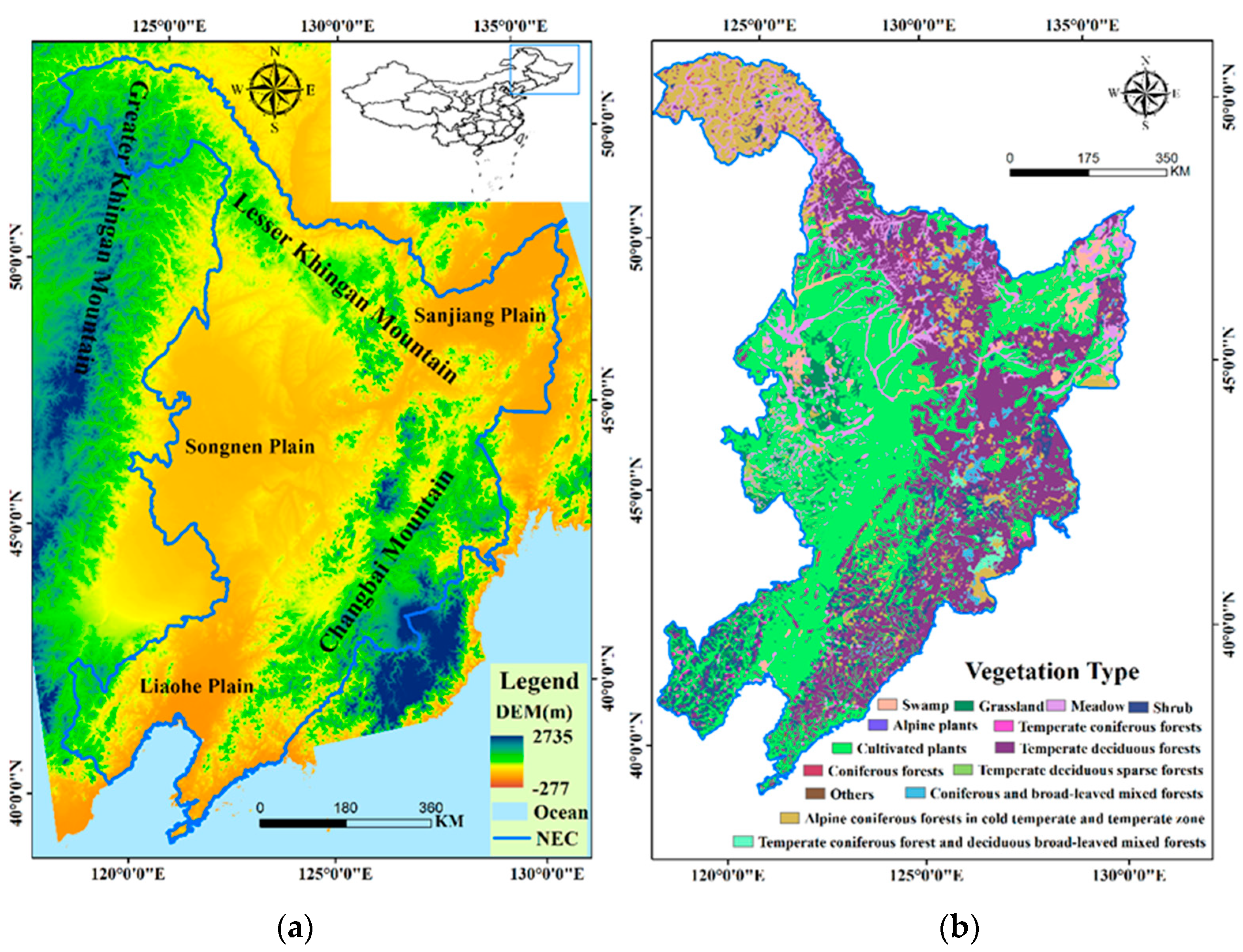

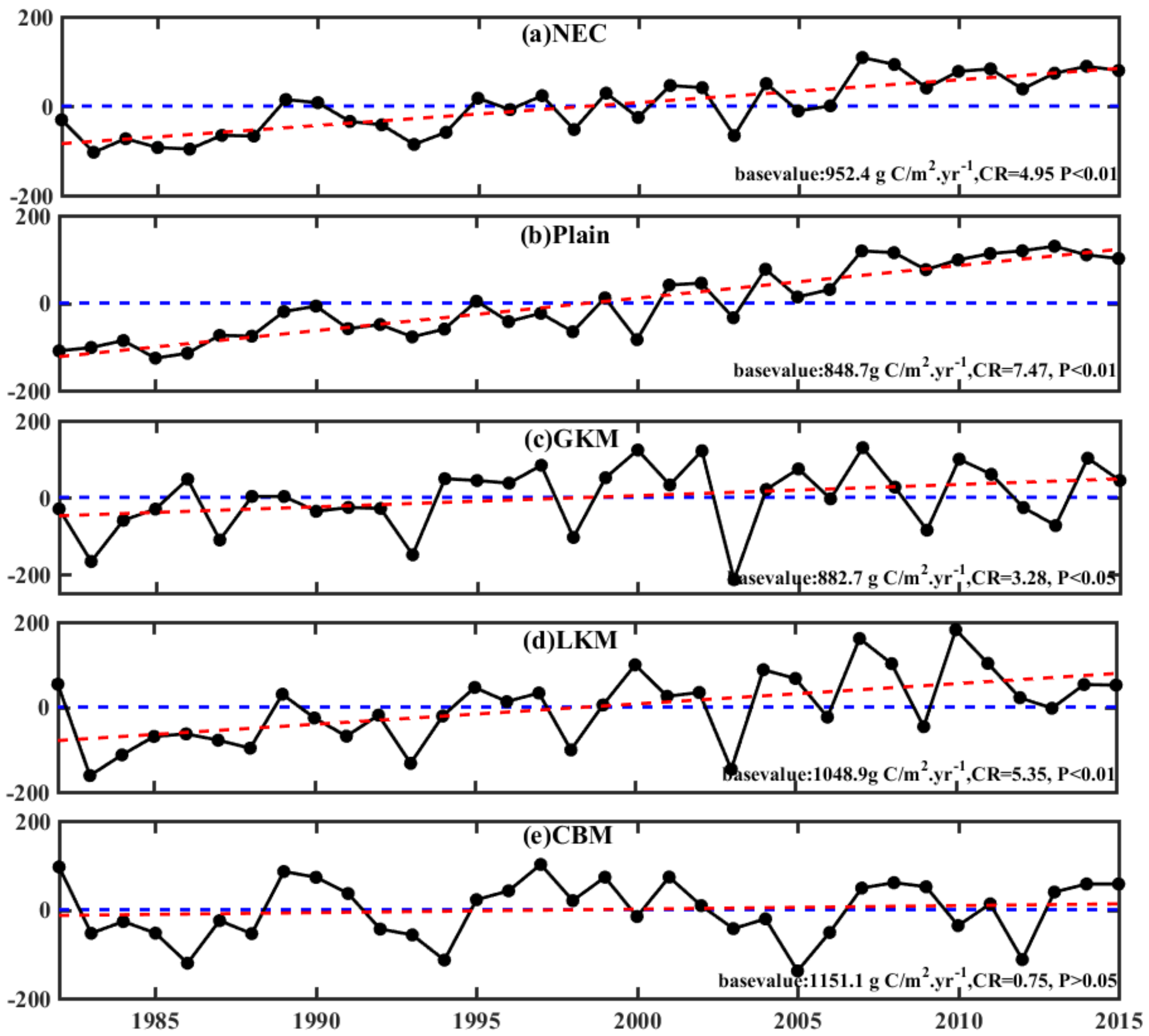
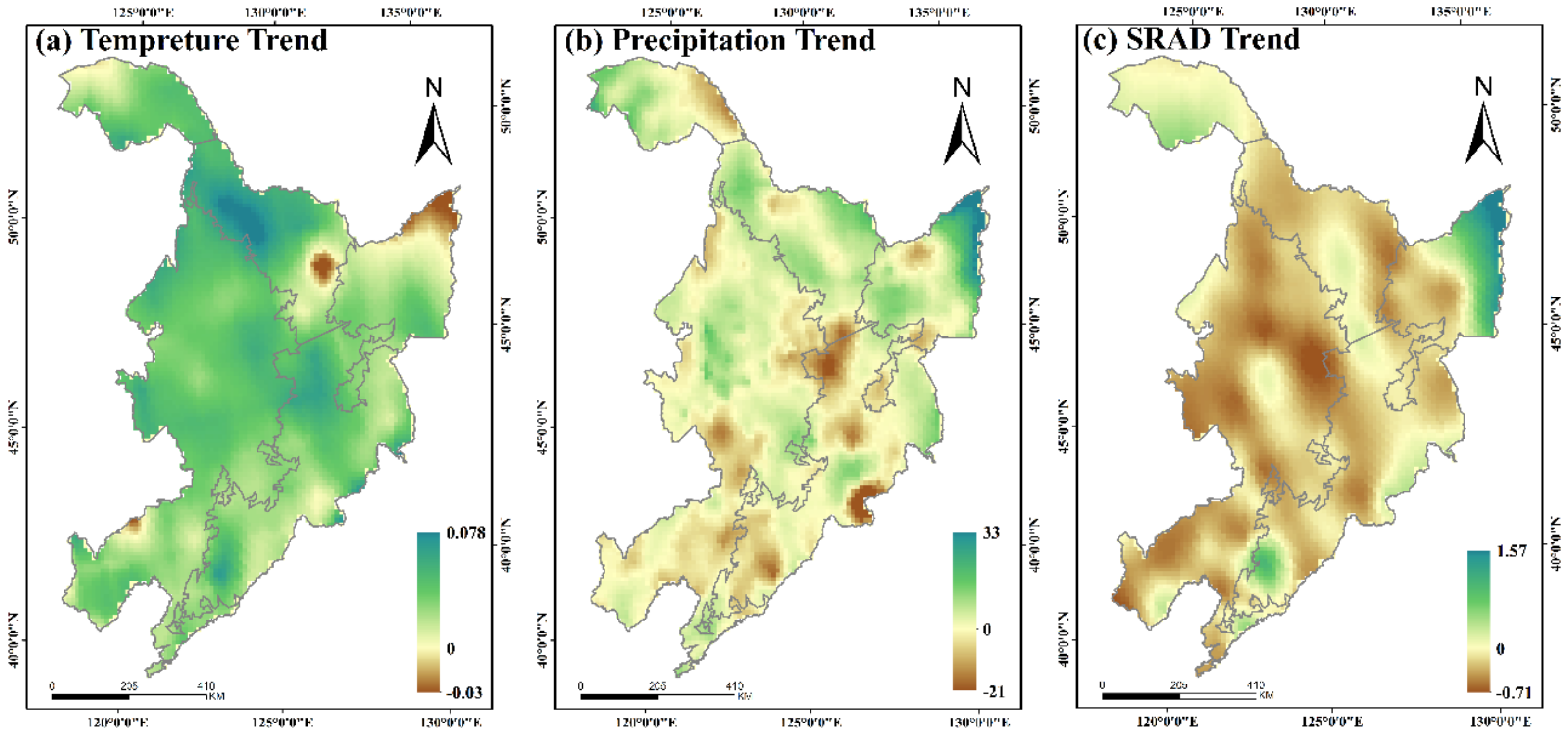
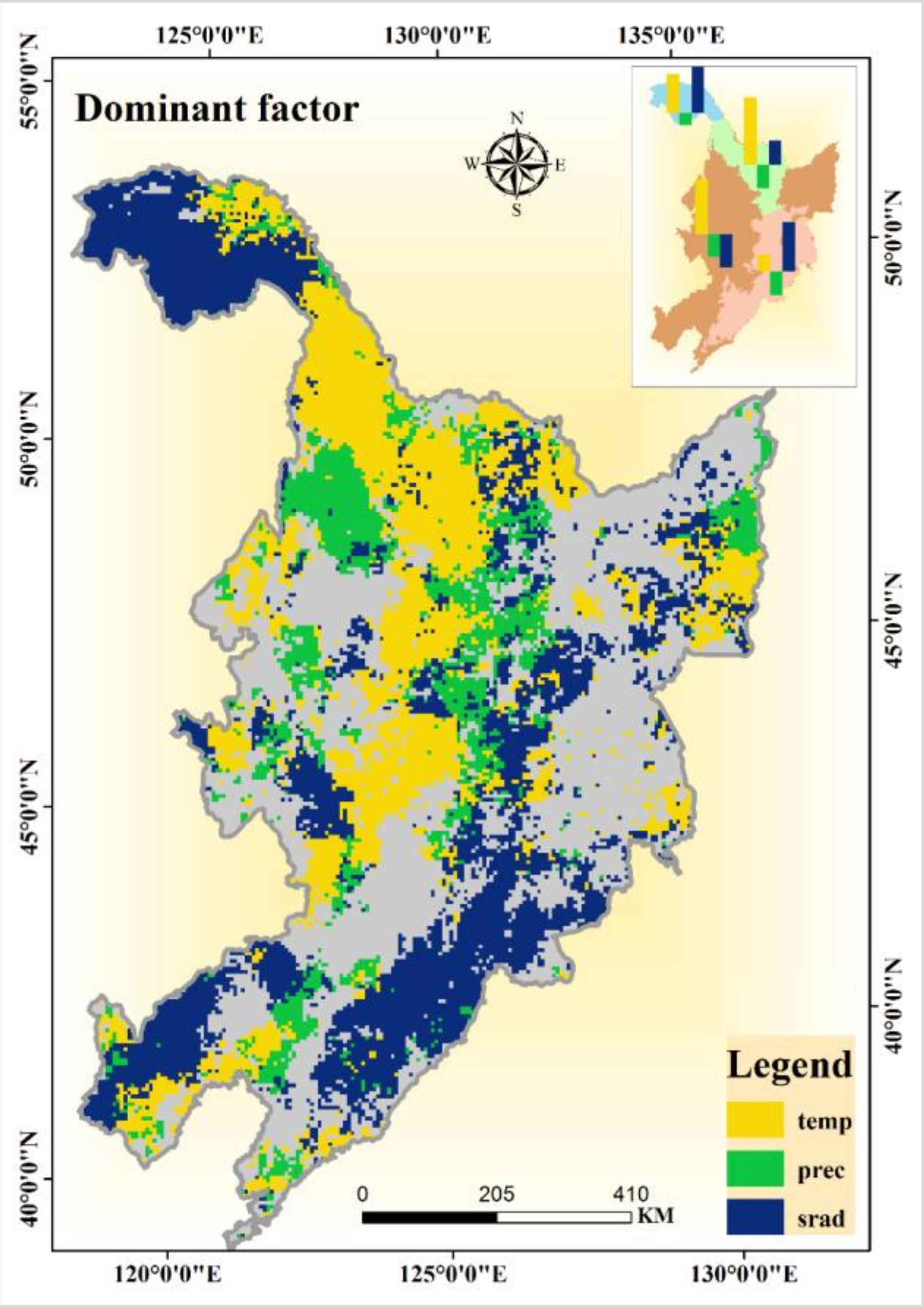
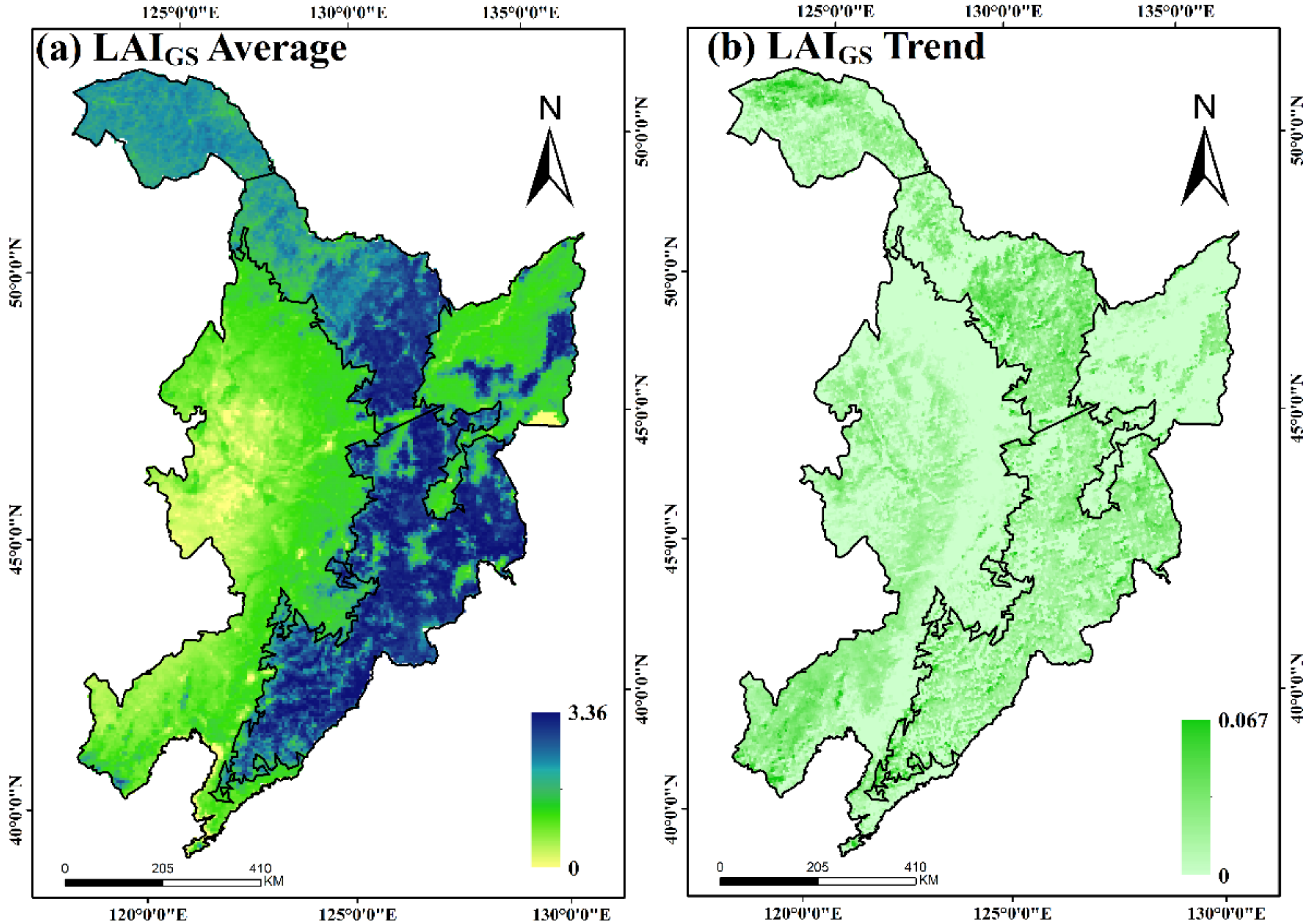
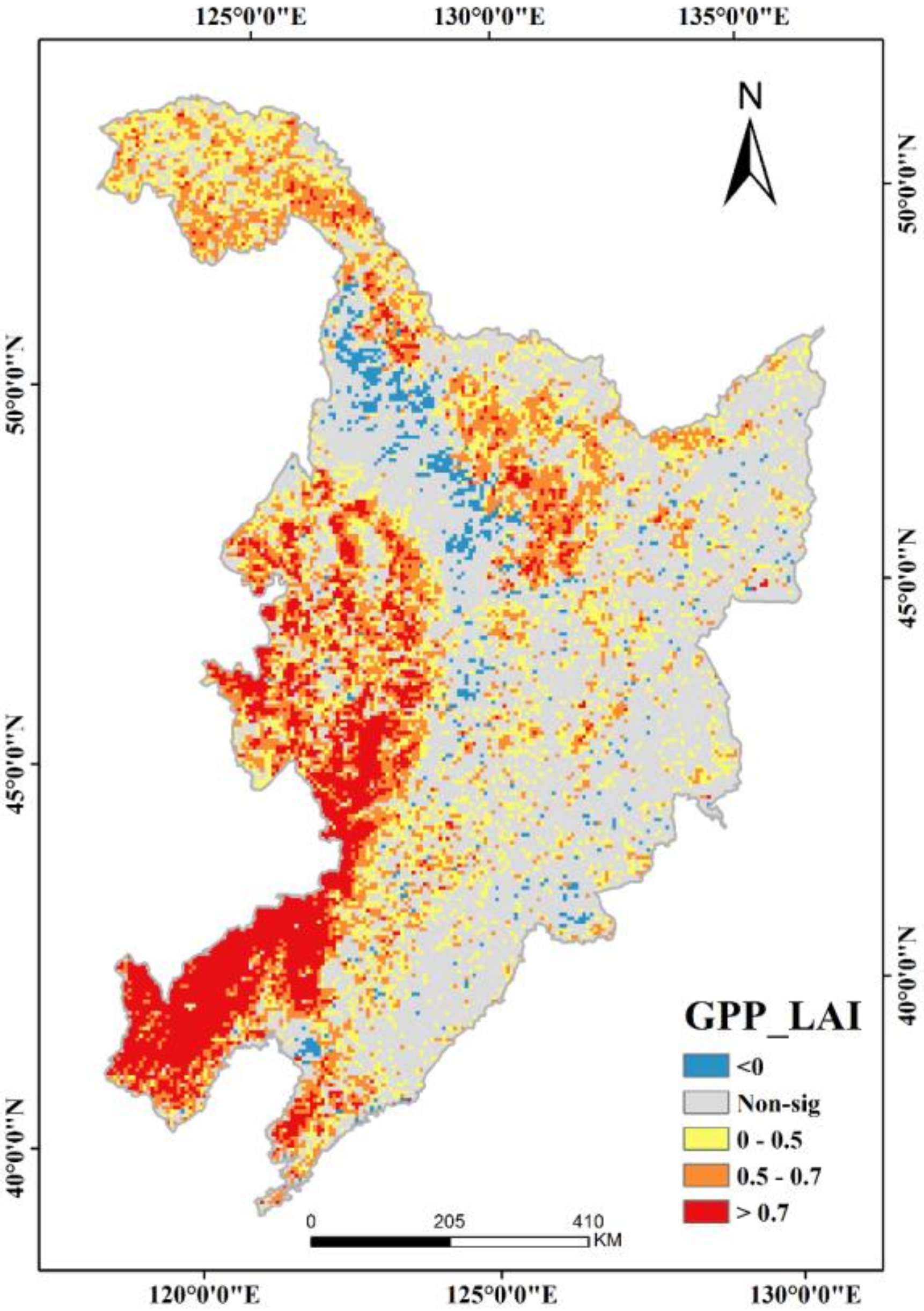
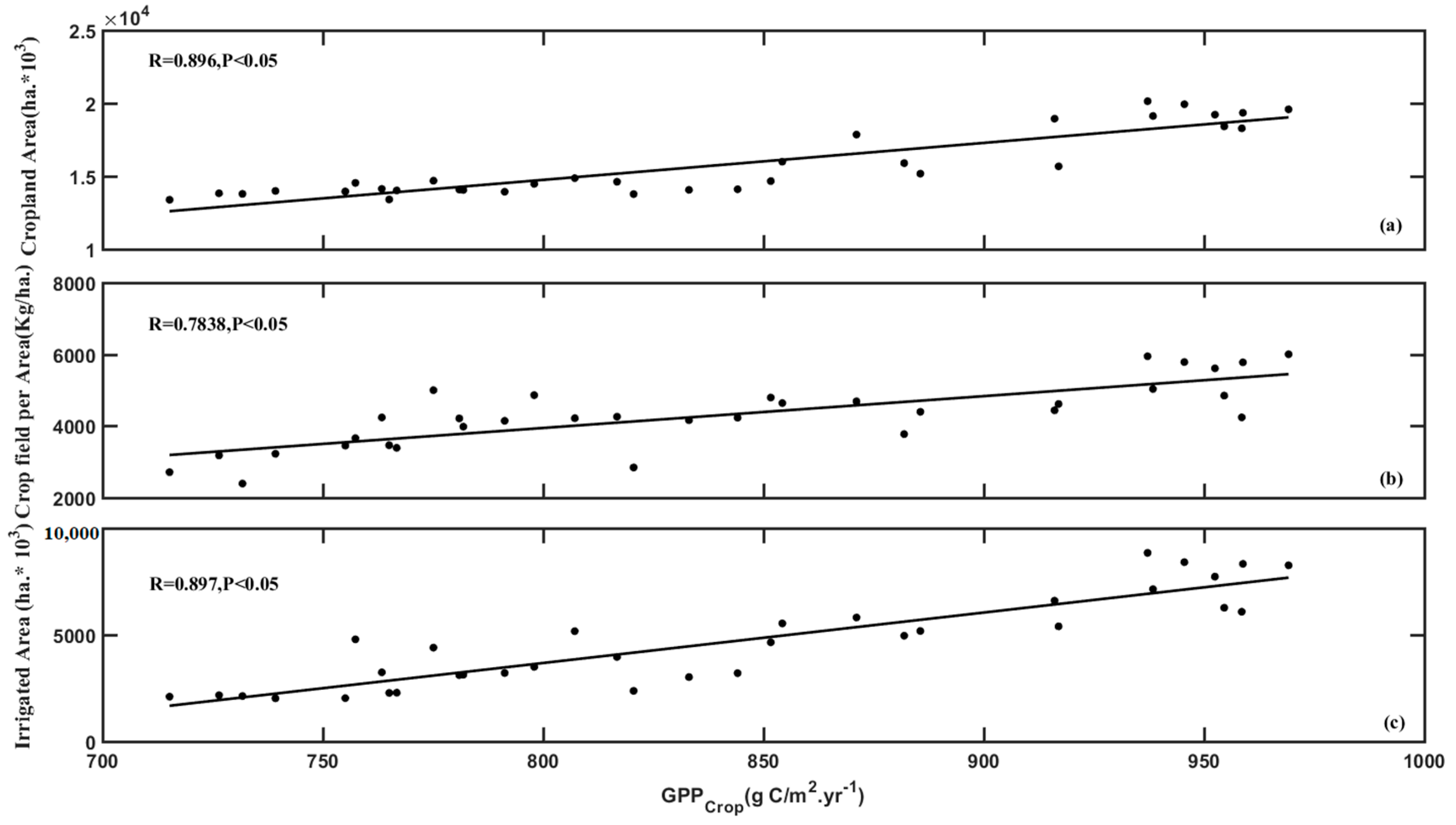
| Temperature | Precipitation | Solar Radiation | ||||
|---|---|---|---|---|---|---|
| CC | PCC | CC | PCC | CC | PCC | |
| Plain | 0.467 ** | 0.479 ** | 0.018 | −0.149 | −0.134 | −0.218 |
| GKM | 0.501 ** | 0.512 ** | −0.433 ** | −0.165 | 0.776 ** | 0.695 ** |
| LKM | 0.590 ** | 0.628 ** | −0.376 * | −0.202 | 0.389 * | 0.189 |
| CBM | 0.238 | 0.177 | −0.483 ** | −0.199 | 0.567 ** | 0.391 * |
| GPPGS | LAIGS | |||
|---|---|---|---|---|
| ACR | RCR | ACR | RCR | |
| GKM | 2.88 | 11.24 | 0.014 | 22.26 |
| LKM | 4.77 | 15.51 | 0.012 | 17.46 |
| CBM | 0.79 | 2.33 | 0.012 | 15.84 |
| Plain | 7.345 | 29.75 | 0.0057 | 15.18 |
Publisher’s Note: MDPI stays neutral with regard to jurisdictional claims in published maps and institutional affiliations. |
© 2021 by the authors. Licensee MDPI, Basel, Switzerland. This article is an open access article distributed under the terms and conditions of the Creative Commons Attribution (CC BY) license (http://creativecommons.org/licenses/by/4.0/).
Share and Cite
Hu, L.; Fan, W.; Yuan, W.; Ren, H.; Cui, Y. Spatiotemporal Variation of Vegetation Productivity and Its Feedback to Climate Change in Northeast China over the Last 30 Years. Remote Sens. 2021, 13, 951. https://doi.org/10.3390/rs13050951
Hu L, Fan W, Yuan W, Ren H, Cui Y. Spatiotemporal Variation of Vegetation Productivity and Its Feedback to Climate Change in Northeast China over the Last 30 Years. Remote Sensing. 2021; 13(5):951. https://doi.org/10.3390/rs13050951
Chicago/Turabian StyleHu, Ling, Wenjie Fan, Wenping Yuan, Huazhong Ren, and Yaokui Cui. 2021. "Spatiotemporal Variation of Vegetation Productivity and Its Feedback to Climate Change in Northeast China over the Last 30 Years" Remote Sensing 13, no. 5: 951. https://doi.org/10.3390/rs13050951
APA StyleHu, L., Fan, W., Yuan, W., Ren, H., & Cui, Y. (2021). Spatiotemporal Variation of Vegetation Productivity and Its Feedback to Climate Change in Northeast China over the Last 30 Years. Remote Sensing, 13(5), 951. https://doi.org/10.3390/rs13050951








